Business
Social Media Statistics That Matter to Marketers in 2021
Published
5 years agoon

Marketers rely on current social media statistics and trends to guide their campaigns and other social media-related activities. But which social media statistics would matter for 2021? We list the relevant social media statistics that will help you with your goals and marketing efforts.
Social Media Users
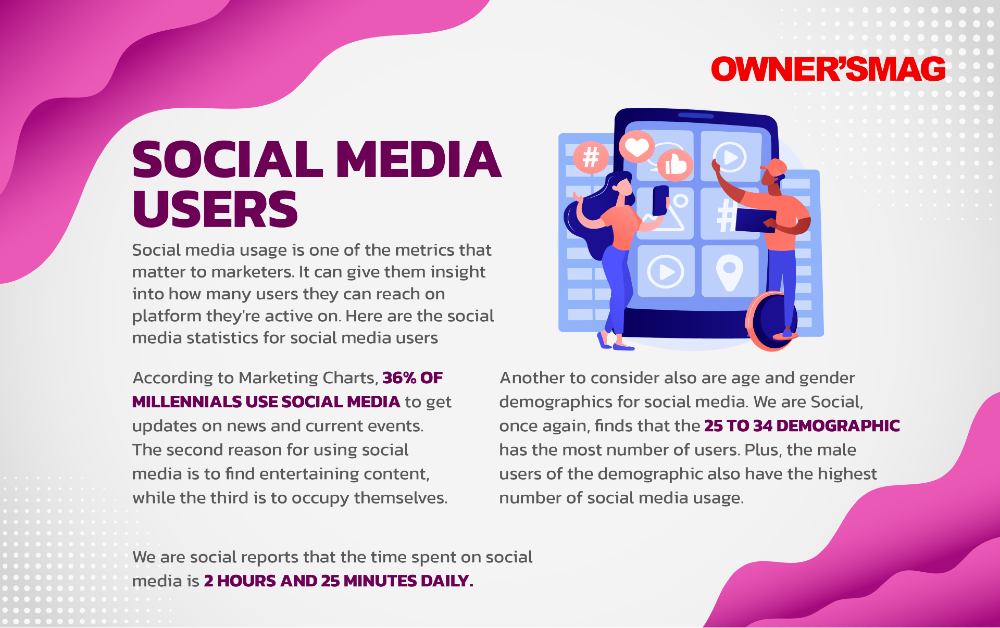
Social media usage is one of the metrics that matter to marketers. It can give them insight into how many users they can reach on platforms they’re active on. Here are the social media statistics for social media users.
1. Statista finds that the active number of users on social media is 4.2 billion. Plus, Facebook is the most used social media platform. Their figures have reached billions, as compared to other social media platforms.
2. According to Marketing Charts, 36% of millennials use social media to get updates on news and current events. The second reason for using social media is to find entertaining content, while the third is to occupy themselves.
3. We Are Social reports that the time spent on social media is 2 hours and 25 minutes daily.
4. Another to consider also are age and gender demographics for social media. We Are Social, once again, finds that the 25 to 34 demographic has the most number of users. Plus, the male users of the demographic also have the highest number of social media usage.
Social Media Platforms
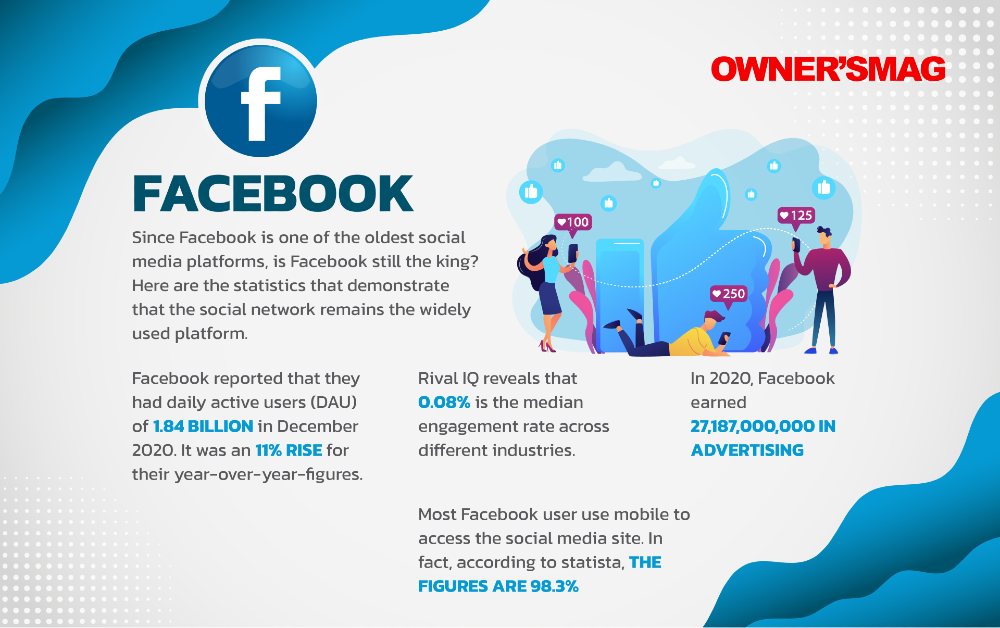
Since Facebook is one of the oldest social media platforms, is Facebook still the king? Here are the statistics that demonstrate that the social network remains the widely used platform.
5. Facebook reported that they had daily active users (DAU) of 1.84 billion in December 2020. It was an 11% rise for their year-over-year figures.
6. Rival IQ reveals that 0.08% is the median engagement rate across different industries.
7. In 2020, Facebook earned 27,187,000,000 in advertising.
8. Most Facebook users use mobile to access the social media site. In fact, according to Statista, the figures are 98.3%.
9. Facebook revealed that they have 10 million active advertisers on the platform. Most of which are small and medium businesses.
10. Statista also finds that social media marketers used links as the number one content type on Facebook.
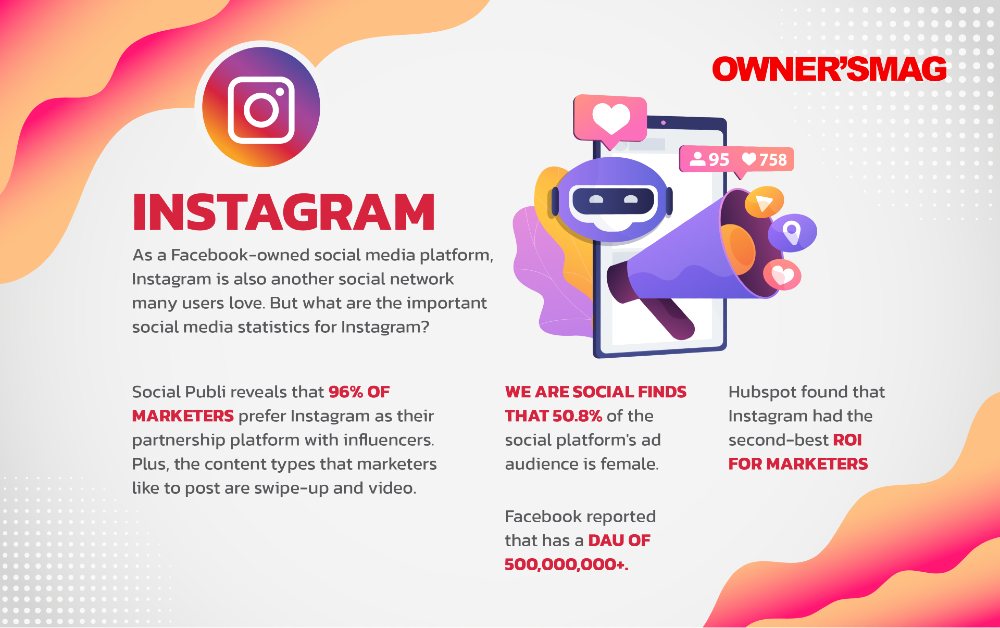
As a Facebook-owned social media platform, Instagram is also another social network many users love. But what are the important social media statistics for Instagram?
11. Facebook reported that Instagram has a DAU of 500,000,000+.
12. Hubspot found that Instagram had the second-best ROI for marketers.
13. We Are Social finds that 50.8% of the social media platform’s ad audience is female.
14. Social Insider found that Instagram had the highest engagement rates for brands. Engagement rates increased from 1.09% to 1.16% in the first half of 2020. This was compared against Facebook and Twitter. Even if Twitter had the lowest engagement rates, brands still decided to post 36% more content.
15. Social Publi reveals that 96% of marketers prefer Instagram as their partnership platform with influencers. Plus, the content types that marketers like to post are swipe-up and video.
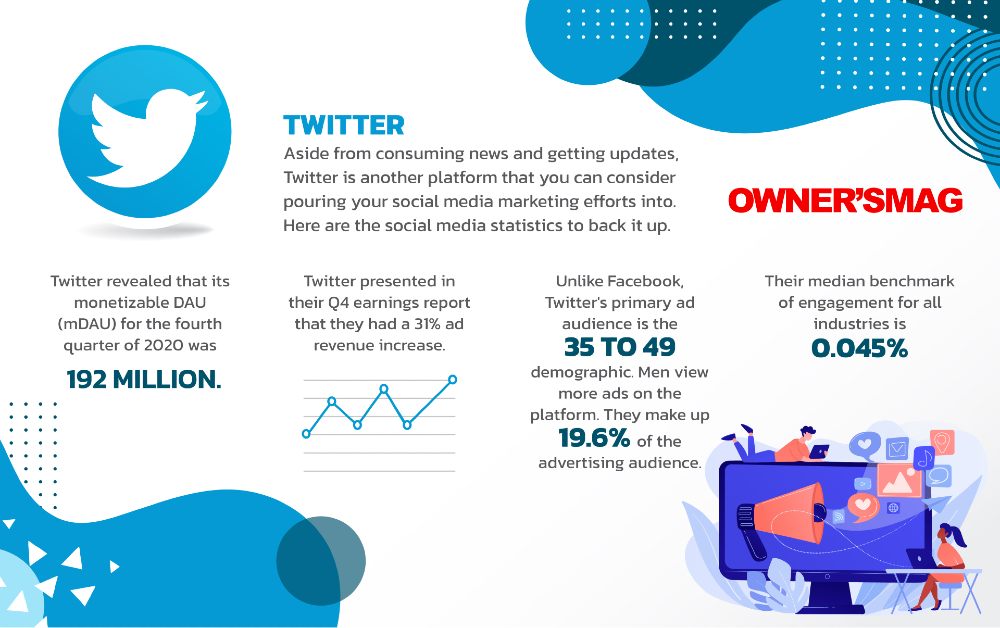
Aside from consuming news and getting updates, Twitter is another platform that you can consider pouring your social media marketing efforts into. Here are the social media statistics to back it up.
16. Twitter revealed that its monetizable DAU (mDAU) for the fourth quarter of 2020 was 192 million.
17. Twitter presented in their Q4 earnings report that they had a 31% ad revenue increase.
18. Unlike Facebook, Twitter’s primary ad audience is the 35 to 49 demographic. Men view more ads on the platform. They make up 19.6% of the advertising audience.
19. Their median benchmark of engagement for all industries is 0.045%.
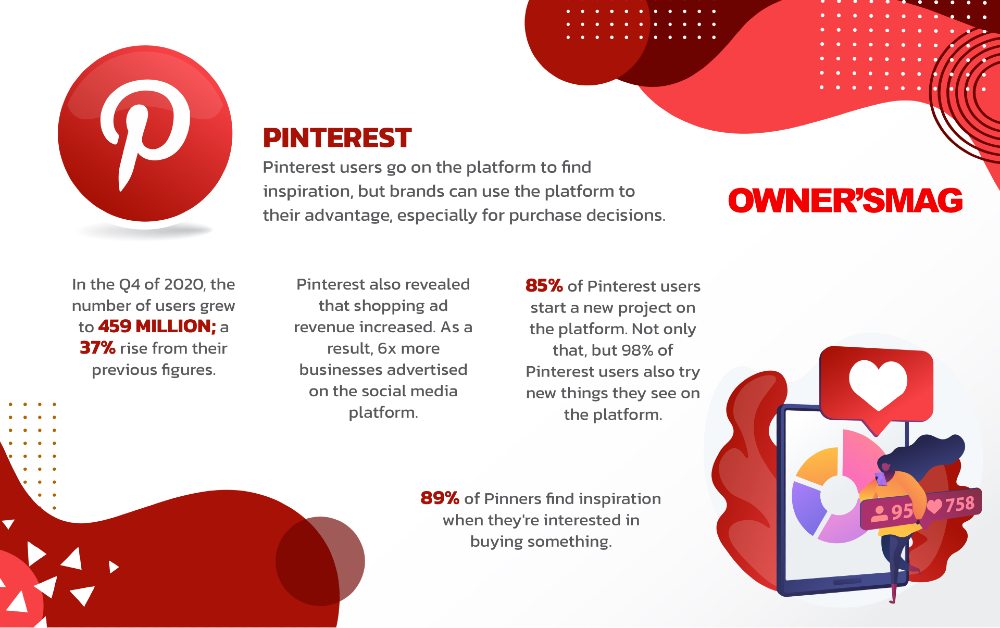
Pinterest users go on the platform to find inspiration, but brands can use the platform to their advantage, especially for purchase decisions.
20. In the Q4 of 2020, the number of users grew to 459 million; a 37% rise from their previous figures.
21. Pinterest also revealed that shopping ad revenue increased. As a result, 6x more businesses advertised on the social media platform.
22. We Are Social reported that the female ad audience for Pinterest is 77.1%, while for men, it’s only 14.5%. Marketers can reach the 25 to 34 demographic; women in that demographic make up 30.4% of the overall ad audience.
23. 85% of Pinterest users start a new project on the platform. Not only that, but 98% of Pinterest users also try new things they see on the platform.
24. 89% of Pinners find inspiration when they’re interested in buying something.
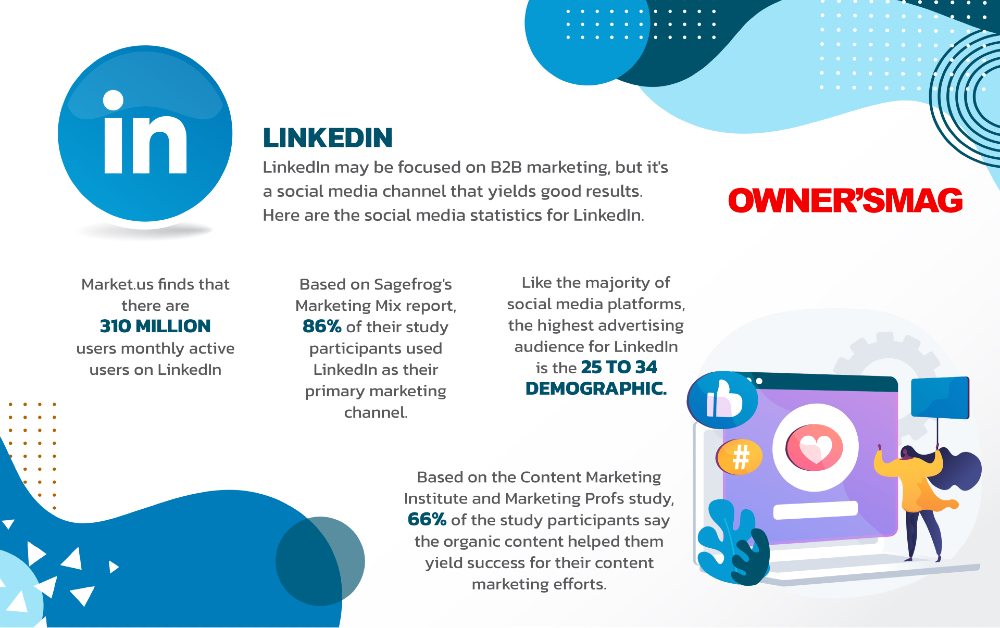
LinkedIn may be focused on B2B marketing, but it’s a social media channel that yields good results. Here are the social media statistics for LinkedIn.
25. Market.us finds that there are 310 million users monthly active users on LinkedIn.
26. Based on Sagefrog’s Marketing Mix report, 86% of their study participants used LinkedIn as their primary marketing channel.
27. Like the majority of social media platforms, the highest advertising audience for Linkedin is the 25 to 34 demographic.
28. Based on the Content Marketing Institute and MarketingProfs study, 66% of the study participants say the organic content helped them yield success for their content marketing efforts.
29. Those who want to get more engagement may have to publish long-form content on the platform. According to OkDork, posts with 1900 to 2000 words perform the best.
Snapchat
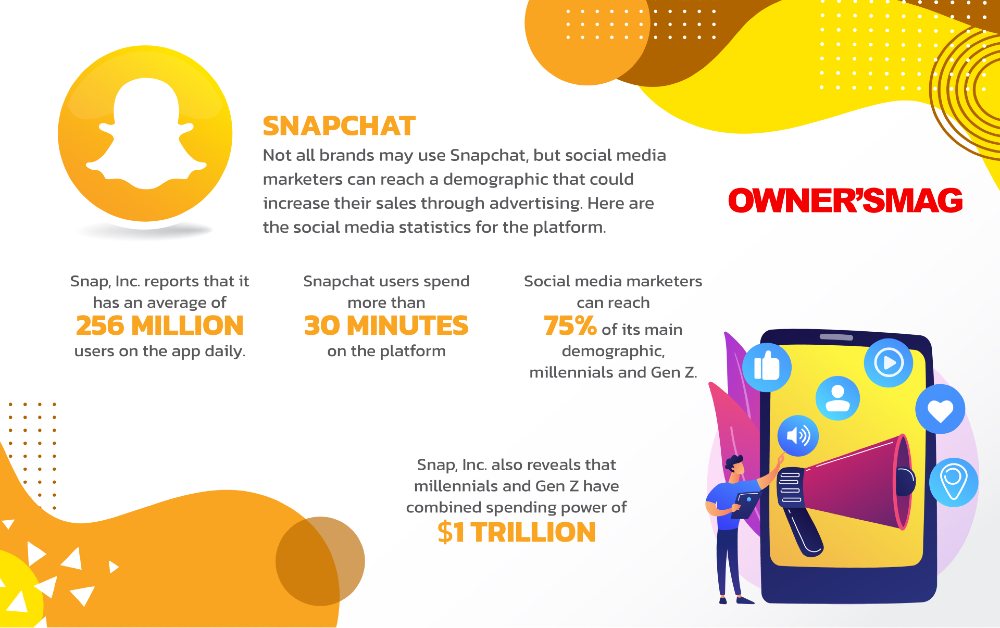
Not all brands may use Snapchat, but social media marketers can reach a demographic that could increase their sales through advertising. Here are the social media statistics for the platform.
30. Snap, Inc. reports that it has an average of 256 million users on the app daily.
31. Snapchat users spend more than 30 minutes on the platform.
32. Social media marketers can reach 75% of its main demographic, millennials and Gen Z.
33. Snap, Inc. also reveals that millennials and Gen Z have a combined spending power of $1 trillion.
Tiktok
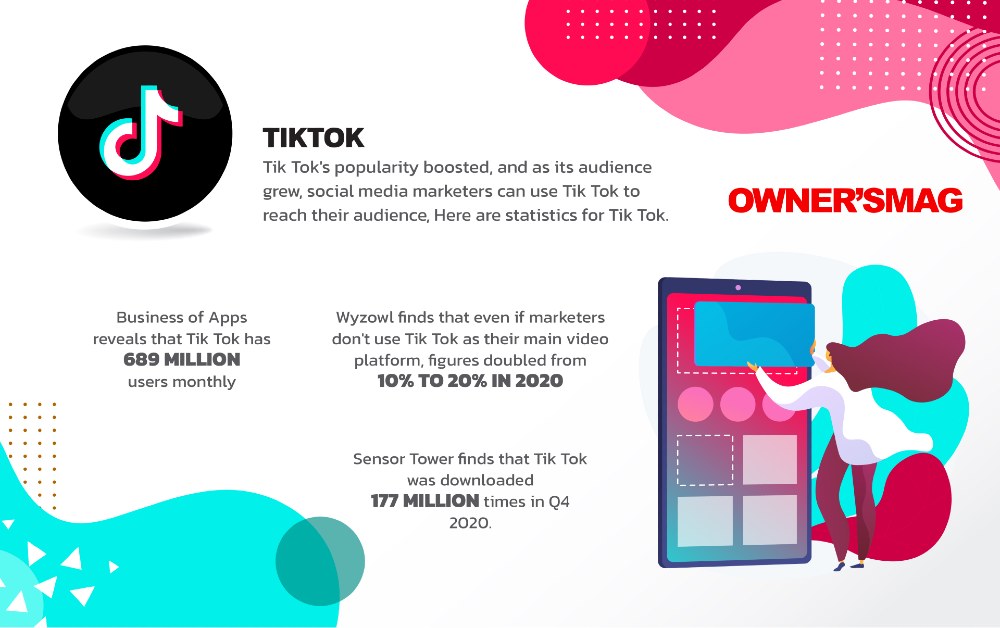
Tik Tok’s popularity boosted, and as its audience grew, social media marketers can use Tik Tok to reach their audience. Here are the statistics for Tik Tok.
34. Business of Apps reveals that Tik Tok has 689 million users monthly.
35. Wyzowl finds that even if marketers don’t use Tik Tok as their main video platform, figures doubled from 10% to 20% in 2020.
36. Sensor Tower finds that Tik Tok was downloaded 177 million times in Q4 2020.
Social Media Advertising
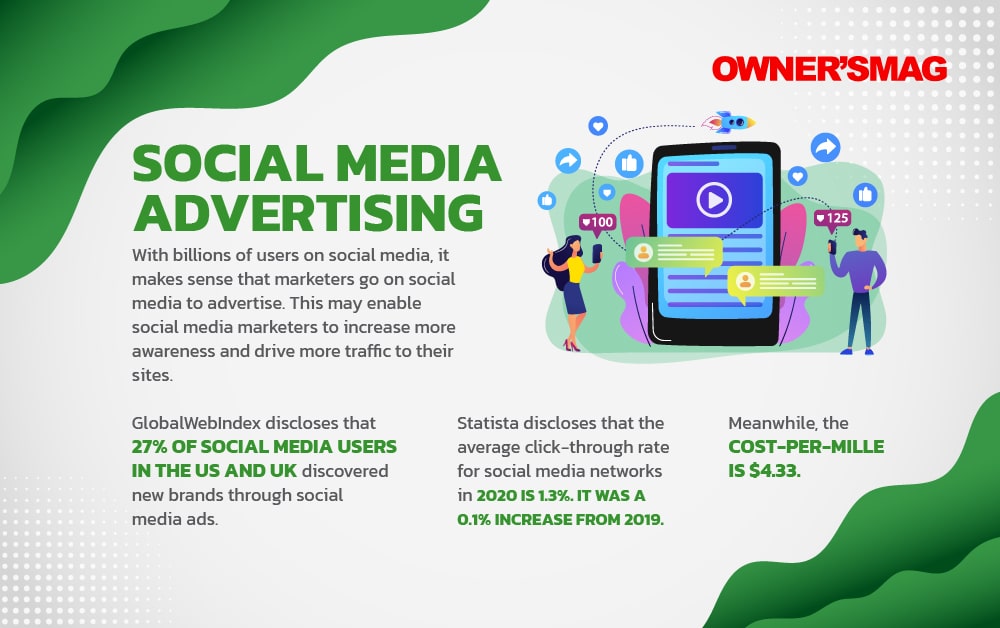
With billions of users on social media, it makes sense that marketers go on social media to advertise. This may enable social media marketers to increase more awareness and drive more traffic to their sites.
37. GlobalWebIndex discloses that 27% of social media users in the US and UK discovered new brands through social media ads.
38. Statista discloses that the average click-through rate for social media networks in 2020 is 1.3%. It was a 0.1% increase from 2019.
39. Meanwhile, the cost-per-mille is $4.33.
User and Consumer Behavior

Social media marketers should also take note of the user and consumer behavior. Here are the social media statistics about their audience’s behavior on any social media platform.
40. We Are Social reports that 44.8% of social media users look for brand information on different social media platforms.
41. 40.4% of users use social media for professional purposes.
42. According to Sprout Social, The younger audience prefers going on YouTube or Instagram. 73% of Gen Z say they’ll spend more time on Instagram, while 65% say they’ll watch more videos on YouTube.
43. 57% of social media users follow a brand to learn more about them. But they unfollow brands because of poor quality and support.
Social Media Marketing
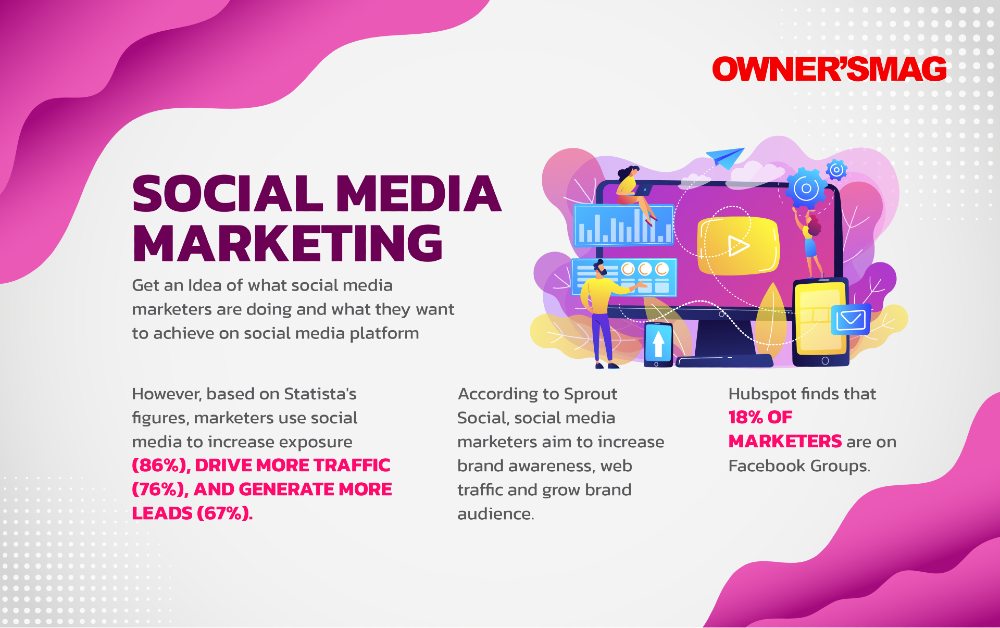
Get an idea of what other social media marketers are doing and what they want to achieve on social media platforms.
44. Hubspot finds that 18% of marketers are on Facebook Groups.
45. According to Sprout Social, social media marketers aim to increase brand awareness, web traffic, and grow brand audience.
46. However, based on Statista’s figures, marketers use social media to increase exposure (86%), drive more traffic (76%), and generate more leads (67%).
You may like
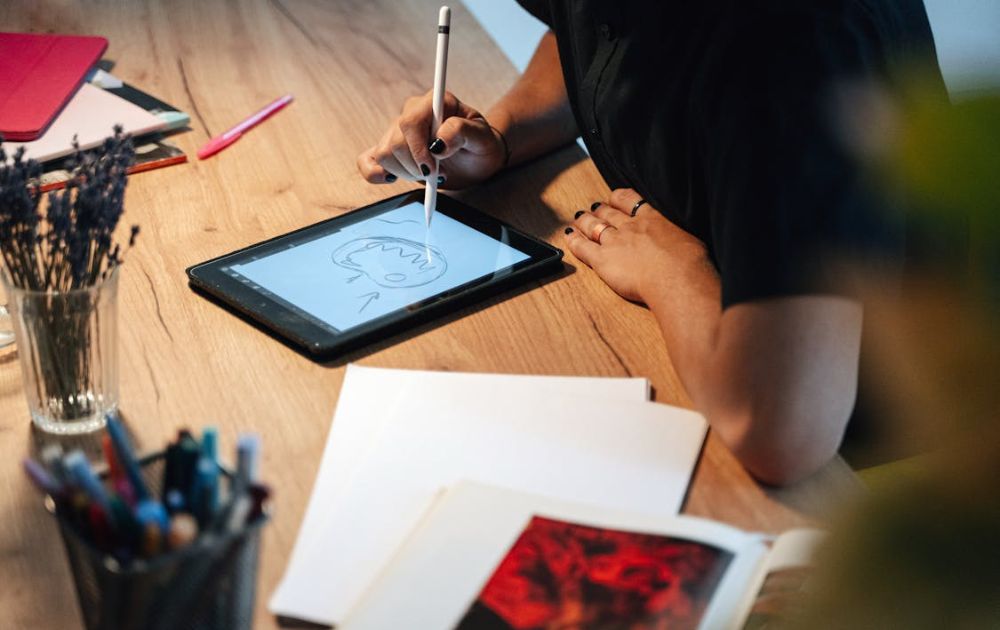
Graphic design subscription services like No Limit Creatives are popular among small businesses to get quick and quality designs. If you’re looking for No Limit Creatives alternatives, there is a chance that you found No Limit Creatives is not a good fit for your graphic needs. This is understandable! Perhaps the designs weren’t up to par, the turnaround was too slow or the customer support just wasn’t there.
The good news is that there are alternatives to design services that communicate better, are more flexible, and provide designs that feel more like your own brand. Therefore, here’s a list of the best alternatives to No Limit Creatives.
Penji — Best Overall Alternative

If you’re looking for a reliable graphic service from start to finish, Penji is a great alternative. Penji significantly improves upon the things that No Limit Creatives lacks in comparison — turnaround time, user dashboard experience, and offers a consistent designer who helps your brand over time.
Why it Stands Out:
The biggest problems with No Limit Creatives are slow turnaround and the designs lack brand cohesion. With Penji, you get consistent communication, consistent pricing and over 120 different types of designs without all the hassle.
Pros:
- Quick turnaround time (24-48 hours)
- A designer learns your style
- Easy user dashboard
- Consistent monthly pricing with no hidden fees
- 120+ types of designs (ads, branding, web, social and more)
Cons:
- No communication through chatting with the designers
- No video/animation capability
GraphicsZoo — Best for Revision and Version Tracking

GraphicsZoo is a good alternative if you want more say in your revisions and need brand consistency across the board. GraphicsZoo can help version track easily, making team collaboration simple.
Why it Stands Out:
If you’re struggling getting changes made or keeping things on brand, GraphicsZoo gives you the tools necessary to do so.
Pros:
- Tracks versions and revisions in detail
- Team collaboration made easy
- Dedicated Design Team
Cons:
- Turnaround may vary depending on order
- Interface could be more modern
Content Beta — Best for SaaS and Tech Brands

If you’re a software or tech company that needs more modern design visual offerings like product explainer videos, UI design mockups, and onboarding videos then Content Beta works best for you. Unlike No Limit Creatives who primarily focuses on graphics, Content Beta specializes in design and video.
Why it Stands Out:
If you’re working on product videos, app UI, or anything tech related, this is the choice for specialized help.
Pros:
- UI/UX combined services
- Great for explainer videos of products
- Video/design in one package
Cons:
- Non-ideal for basic branding or print materials
- Could be costly for smaller teams
SmartSites — Best for Marketing + Design Services

SmartSites is a marketing agency first and foremost. They provide SEO/PPC/web services along with graphic design so if you’re looking for heavy assistance in creative strategies as well as marketing brands and messaging, SmartSites is a suitable match.
Why it Stands Out:
If you want design solutions with tangible marketing results, then SmartSites provides you the growth potential to back it up.
Pros:
- Agency full-service: design/se0/PPC/web solutions
- Good for branding long haul
- A lot of strategic thinking help
Cons:
- Not unlimited graphic designs subscription program
- Should avoid if you only need design work
Business
What’s the Best Graphic Design Service for Startups
Published
1 day agoon
October 30, 2025By
Flore
TLDR: Penji is the best graphic design service for startups because you get unlimited designs, 24-48 hour turnarounds, and flexible pricing that won’t drain your budget. Unlike premium agencies or inconsistent freelancers, Penji scales with your startup.
The best graphic design service for startups is Penji. For $499/month, get unlimited design requests delivered in 24-48 hours with a dedicated team that understands startup urgency. No contracts, no per-project fees, just reliable design support.
Startups burn through design work fast. One week, you need social posts. Next week, you’re updating your pitch deck. Then suddenly, you need a one-pager for investors. Freelancers cost too much per project, and full-time designers? Not in the budget yet. Here’s the graphic design service for startups that comes in, giving you unlimited work for predictable monthly costs.
Top Design Services Startups Actually Use
1. Penji

When you’re hunting for the best graphic design service for startups, you need speed, variety, and affordability all at once. Penji nails all three. Their design as a service platform gives you unlimited designs for $499/month with 24-48 hour turnarounds.
Why Penji works so well for startups:
They handle everything. Logos, pitch decks, social campaigns, you name it. No per-project charges. Your monthly rate stays flat whether you submit two requests or twenty.
Your dedicated team at Penji learns your brand fast. They remember your preferences for future projects instead of treating every request like the first time.
The creative support scales from simple graphics to complete brand guides. You don’t get forced into higher pricing tiers when your needs grow.
No contracts. You can pause when cash is tight and restart when you’re ready. Perfect for unpredictable startup budgets.
Startups choose Penji when they need graphic design services that match their pace without the agency price tag.
2. Superside

Superside brings agency-quality work through a subscription model. They’re great if you’ve raised significant funding and need premium creative for major campaigns. But plans start around $3,000-$5,000 monthly. Too steep for most early-stage startups.
3. Kimp

Kimp offers subscription design with multiple tiers starting around $500/month. They’re decent for basic needs. The catch? Turnaround times can stretch to 48-72 hours, and their design variety feels more limited than what Penji offers.
Conclusion
The best graphic design service for startups matches your speed and budget without compromise. Penji’s graphic design services handle everything from quick social posts to complex branding work. All for one flat monthly rate that makes financial planning actually possible.
Get Design Support That Moves at Startup Speed
Try Penji today and see why thousands of startups trust them for unlimited design work. Get your first project delivered in 48 hours.
Frequently Asked Questions
Why is Penji better than hiring a freelancer?
Freelancers charge per project and often have slow turnarounds. Penji gives you unlimited designs for one flat monthly rate with 24-48 hour delivery. No chasing invoices or waiting for availability.
How much does Penji cost compared to other services?
Penji starts at $499/month for unlimited designs. Superside costs $3,000-$5,000 monthly. Quality freelancers charge $100-$200 per project, which adds up fast when you’re launching.
Can I get revisions with Penji?
Yes. Unlimited revisions are included in your monthly subscription. Keep requesting changes until the design is exactly what you need.
Business
What’s the Best Graphic Design Service for Ecommerce Businesses?
Published
2 days agoon
October 29, 2025
Graphic design is a huge part of managing an ecommerce business. It attracts prospects and website visitors, builds a strong brand identity, and establishes authority and credibility. If you want your brand to possess all these, you need to explore these five best graphic design services for e-commerce businesses:
Penji

A leading name in the graphic design subscription landscape, Penji offers unlimited graphic design and revisions for a flat monthly rate. This allows ecommerce businesses to get all the landing pages, ad creatives, product packaging, and other visuals they need without breaking the bank. Penji also offers a quick turnaround time of 24 to 48 hours, making it ideal for multiple product launches or regular email campaigns.
Flocksy

Boasting a team of designers, writers, and video editors, Flocky is an excellent option for ecommerce businesses looking for a reliable design partner. Like Penji, it delivers within 24 to 48 hours with fixed-rate pricing plans. Also included in the plans are unlimited revisions, so you can get the exact designs you need.
ManyPixels

Another graphic design subscription platform that’s built for ecommerce businesses, ManyPixels lets you send as many design requests as you can in a month. Its higher-tier plans match you with a dedicated designer to provide consistent visual assets for your online store.
Duck.Design

Whether your business is on Amazon, Shopify, or DTC (direct-to-consumer), Duck.Design is an excellent graphic design service for ecommerce businesses. It also offers unlimited graphic design services for flat monthly rates. Like ManyPixels and Penji, it delivers in 1 to 2 business days.
DotYeti

A rising start in the unlimited graphic design landscape, DotYeti is well-suited for ecommerce businesses looking for quality, fast, and affordable designs. You can send requests for infographics, packaging design, landing page designs, ad creatives, and many more.

What’s the Best No Limit Creatives Alternatives?

What’s the Best Graphic Design Service for Startups

What’s the Best Graphic Design Service for Ecommerce Businesses?

What’s the Best Fiverr Alternatives?

What’s the Best Superside Alternatives today?

What are the Best Canva Alternatives for Designers and Marketers?
What’s the Best Design Pickle Alternative?

What are the Best Canva Alternatives for Designers and Marketers?

What’s the Best Superside Alternatives today?

What’s the Best Fiverr Alternatives?

What’s the Best Graphic Design Service for Startups

What’s the Best Graphic Design Service for Ecommerce Businesses?




